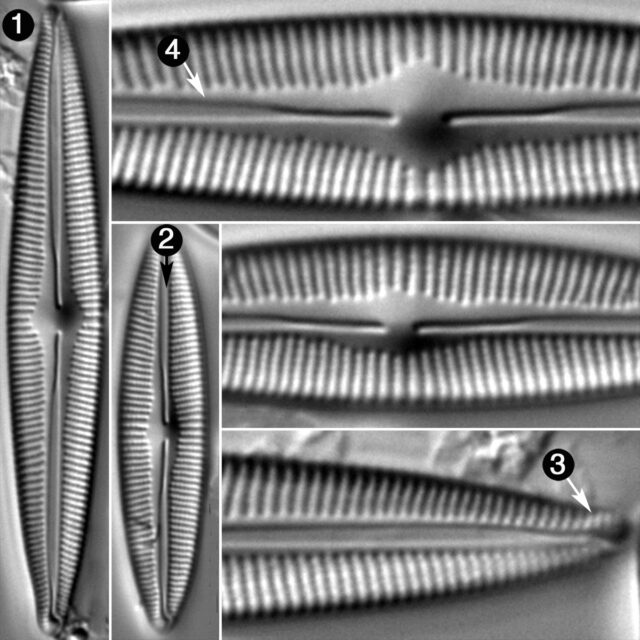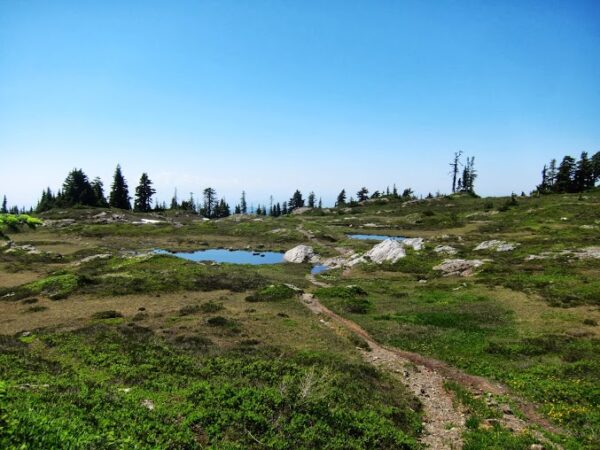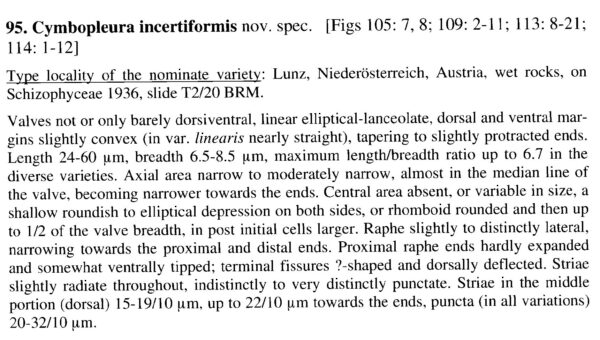Cymbopleura incertiformis
-
Category
-
Length Range29.5-60.7 µm
-
Width Range7.0-9.4 µm
-
Striae in 10 µm14-17 at the valve center, 20-24 at the ends on the dorsal side
-
ContributorLoren Bahls - Jan 2014
-
ReviewerDiane Winter - Mar 2014
Identification
Description
Valves are lanceolate and not, or just barely, dorsiventral. Apices are either not protracted, or they are weakly protracted and subrostrate. The narrow axial area widens somewhat near the valve center. The central area is rounded and more or less symmetric, formed by shallow depressions on the dorsal and ventral sides. The raphe is lateral, becoming filiform toward the ends. Proximal raphe ends are deflected ventrally and terminate with weakly expanded pores. Distal raphe ends are hooked toward the dorsal side. Striae are radiate throughout and more widely spaced near the valve center. Areolae are difficult to resolve in LM and number 28-32 in 10 µm.
Autecology
Cymbopleura incertiformis is widespread and locally abundant in lakes and ponds of the northern Rocky Mountains and North Cascades. In lakes with water quality data, pH ranged from 6.7 to 7.8 and specific conductance ranged from 10 to 53 µS/cm. Krammer (2003) reports variety incertiformis as "widely distributed in the subarctic, nordic, and alpine area in oligotrophic to dystrophic habitats with commonly low electrolyte content, sometimes in large numbers".
-
Size Range, µm3
-
Motility
-
Attachment
-
Habitat
-
Colony
-
Waterbody
-
Distribution
- Learn more about this
Citations & Links
Cite This Page
Bahls, L. (2014). Cymbopleura incertiformis. In Diatoms of North America. Retrieved November 21, 2024, from https://diatoms.org/species/cymbopleura_incertiformis
Responses
The 15 response plots show an environmental variable (x axis) against the relative abundance (y axis) of Cymbopleura incertiformis from all the stream reaches where it was present. Note that the relative abundance scale is the same on each plot. Explanation of each environmental variable and units are as follows:
ELEVATION = stream reach elevation (meters)
STRAHLER = distribution plot of the Strahler Stream Order
SLOPE = stream reach gradient (degrees)
W1_HALL = an index that is a measure of streamside (riparian) human activity that ranges from 0 - 10, with a value of 0 indicating of minimal disturbance to a value of 10 indicating severe disturbance.
PHSTVL = pH measured in a sealed syringe sample (pH units)
log_COND = log concentration of specific conductivity (µS/cm)
log_PTL = log concentration of total phosphorus (µg/L)
log_NO3 = log concentration of nitrate (µeq/L)
log_DOC = log concentration of dissolved organic carbon (mg/L)
log_SIO2 = log concentration of silicon (mg/L)
log_NA = log concentration of sodium (µeq/L)
log_HCO3 = log concentration of the bicarbonate ion (µeq/L)
EMBED = percent of the stream substrate that is embedded by sand and fine sediment
log_TURBIDITY = log of turbidity, a measure of cloudiness of water, in nephelometric turbidity units (NTU).
DISTOT = an index of total human disturbance in the watershed that ranges from 1 - 100, with a value of 0 indicating of minimal disturbance to a value of 100 indicating severe disturbance.

Cymbopleura incertiformis
- Valves lanceolate
- Valves barely dorsiventral
- Apices weakly protracted
- Axial area narrow
Cymbopleura incertiformis has lanceolate valves that are nearly symmetric, or just barely dorsiventral. Apices are either not protracted, or only weakly protracted. The axial area is narrow.
 Diatoms of North America
Diatoms of North America








